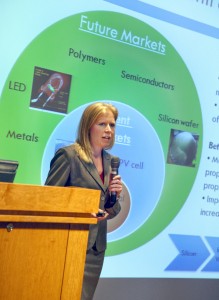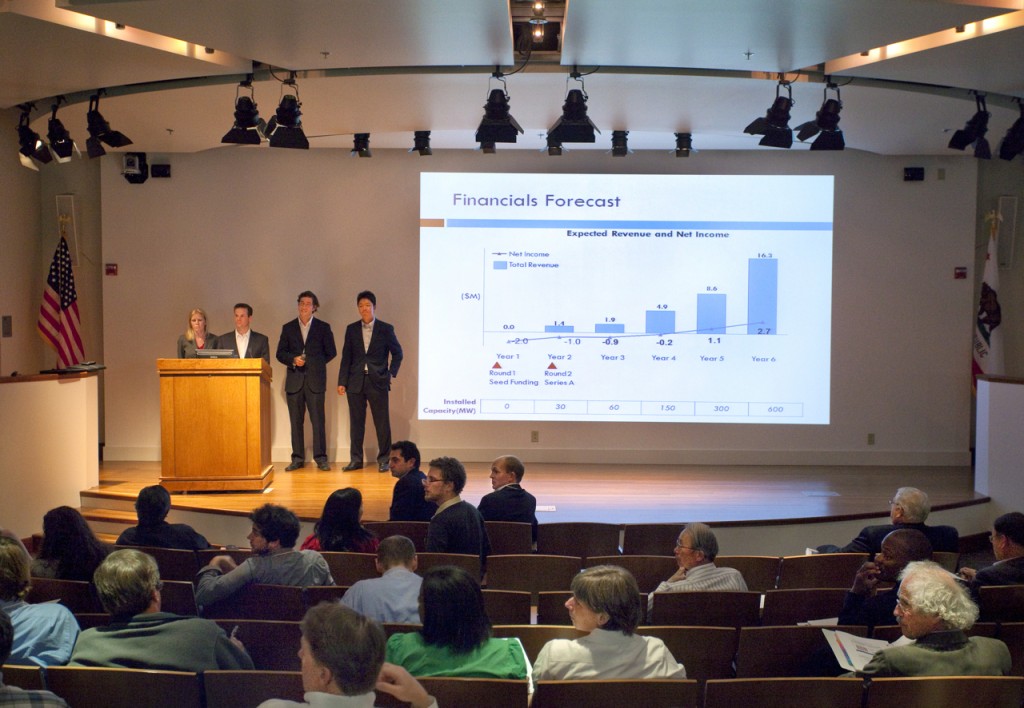Launched as a pilot project at Berkeley Lab, the Cleantech to Market program is finishing its first semester as an official class at UC Berkeley’s Haas School of Business, and it’s safe to say the students learned more than they expected on how to take a technology from the laboratory to the marketplace. What was less expected is how much the scientists got out of the program.
“It was phenomenal,” said Cyrus Wadia, co-director of the C2M program. “They absorbed more information than I ever expected. Then they took my ideas and put a creative spin on them, and went in a direction I hadn’t even thought of.”
Five students took a nanosolar invention by Wadia, who is working at the White House Office of Science and Technology while on a one-year leave from Berkeley Lab, and developed a market strategy and investment pitch around it, after conducting exhaustive market research. Their conclusion: to position the thin film solar technology for the off-grid market in rural areas of developing countries, such as India.

MBA candidate Stephanie Rohrs pitches her team's technology to audience members at the Cleantech to Market program's final presentations.
Similarly, a group of students worked on a thin film silicon solar invention with physicists Alex Zettl, Marvin Cohen and Steve Louie of the Materials Sciences Division and built a mock company around it, which they named Better Silicon. “But for us, this wasn’t just an exercise,” said Zettl. “We’re ready to go. They came up with appropriate business models we thought made sense. I was impressed with how quickly they were up to speed.”
Their presentations were delivered last Friday to an audience of scientists, faculty and energy industry professionals. Started as a pilot project by Berkeley Lab’s Technology Transfer Department, the Berkeley Energy and Resources Collaborative and Haas professor Catherine Wolfram, Cleantech to Market became so popular that it is now housed at the Energy Institute at Haas and was offered as a class for the first time this semester. Nearly 120 students applied for 42 seats. “It’s closer to an incubator than a class,” said program co-director Bev Alexander. “We are receiving many requests to expand.”
Students were assigned to work on one of 10 technologies—half from Berkeley Lab and half from UC Berkeley. The majority of students were in the business school, with a handful coming from programs in law, engineering, sciences and energy and resources. “We were very intentional about matching students with technologies,” said Alexander. “We selected them as if we were creating a company.”
No real startups have emerged from C2M so far, but some interest is starting to emerge. More importantly, the program provides a new pathway for commercializing the inventions produced by Berkeley Lab and UC Berkeley scientists, a path that is more time-consuming than many scientists realize and requires more in-depth research than the technology transfer offices usually have time for.
“The students have provided a deep dive not only into the technologies but also into a broad variety of business models, which is very useful for our scientists,” said Cheryl Fragiadakis, director of Berkeley Lab’s Technology Transfer and Intellectual Property Management Department.
Of course the most important product of the program is the students themselves, who leave C2M savvy about commercializing early-stage technologies, not only giving them a head start, but helping to propel the larger clean tech mission in Berkeley and beyond. “Our collective opportunity in the Berkeley area—on campus, in the labs and across the East Bay Green Corridor—is to continue building our cleantech entrepreneurial community, similar to efforts at Caltech [the California Institute of Technology] and Stanford,” said Alexander. “We want to help do that specifically around energy.”
Berkeley Lab materials scientist Ramamoorthy Ramesh, who participated in C2M last year and plans to do so again this year, said the research and recommendations provided by the students were very valuable. “When I was at the University of Maryland, I did a similar program, and they charged me $3,000,” he said. “The [Berkeley] students were fantastic. One was ready to go do a startup with me.”

Better Solar team members (left to right) Stephanie Rohrs, Allen Brisch, Christian Sjogren and Taejoon Park take questions from the audience after making a pitch for the mock company they formed for the Cleantech to Market business class. (photos by Roy Kaltschmidt, Berkeley Lab Public Affairs)
Industry participation is a key element to the program’s success. “The program exceeded my expectations by far,” said MBA candidate Cristian Sjogren, who worked on the Better Silicon team and plans to start a solar company in his native Chile. “We’re very lucky to have worked with among the top scientists in the world today. And we met with venture capitalists, who gave feedback on our projects, and also lawyers on intellectual property. I could never have gotten that in another course.”
Some credit the class with influencing their career direction. “This class has given me access to clean energy. It helped me make the transitions MBAs are always trying to make,” said MBA candidate Carlo Woods, who used to work in finance and accounting. “My internship this summer is with a solar firm.”
Another student team was assigned a different sort of technology: OpenADR, or Open Automated Demand Response, a communications specification developed at Berkeley Lab to help buildings save power during peak times, which is now in use in more than 200 large facilities in California.
“The team’s assignment was to find ways to accelerate national deployment of this free technology to utilities and control companies,” said Rish Ghatikar from Berkeley Lab, who assisted the students with the project. “It’s different since it is a non-proprietary technology with a lot of societal benefits.”
The students produced a 35-page report as well as a list of the top 10 barriers to adoption and suggestions to overcome each one. One of their recommended actions was to launch a third-party nonprofit to focus on outreach and managing the perceptions of OpenADR.
“Marketing and storytelling are not what the Berkeley Lab people are brilliant at, so they need to find partners,” said student Laura Schewel, who is getting a degree in Energy & Resources. “This project illustrates why we need people to buckle down and execute in the energy field.”
Mary Ann Piette, who helped develop OpenADR, plans to pursue some of the recommendations. “It’s extremely valuable,” she said. “We don’t think the way they do. We have explored many of their ideas, but we need a broad portfolio of outreach strategies.”
Lab researchers with intellectual property or ideas that might be commercialized in the clean tech arena who are interested in participating in the C2M program should contact the Technology Transfer Department at [email protected].
Berkeley Lab is a U.S. Department of Energy (DOE) national laboratory located in Berkeley, California. It conducts unclassified scientific research and is managed by the University of California for the DOE Office of Science. Visit our Website at http://www.lbl.gov.
Additional Information